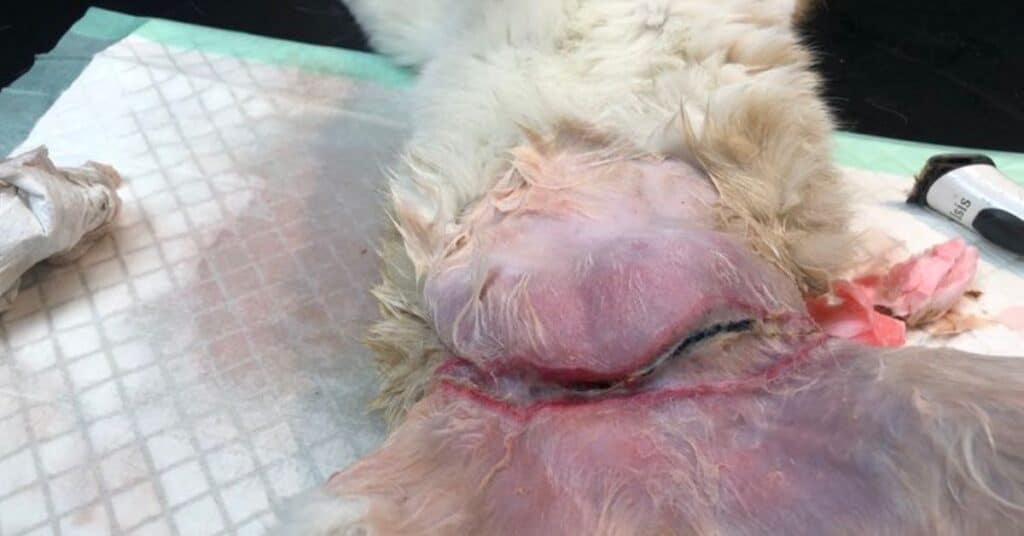When Harry arrived back at his home after five days, his return should have delighted Marion Brownlie. Instead, she was shocked. Harry, a farm cat living with Brownlie, had a deep welt across his abdomen. And it was the result of a snare.
Brownlie lives in St Cyrus, Aberdeenshire, on Scotland’s eastern coast. Harry had gone missing in early May, and Brownlie recovered him from a field near their home five days later. It’s unclear how long the snare had wrapped itself around Harry. However, an image of the cat shows the device had wounded him deeply. Brownlie said she was afraid to pick Harry up after finding him because it looked as though he’d been “cut in two” by the snare.
Fortunately, Harry survived. A vet confirmed his injuries were the result of a snare before carrying out surgery to repair the wound. He was cage-bound while recovering, but was able to get back to full health. Brownlie told Protect the Wild in mid-June that she’d only just let Harry back out of the house for the first time. She was, unsurprisingly, nervous. However, all went well and she said Harry was pleased to be back out and free.

Snares: they cause ‘needless suffering’
By the time Brownlie found Harry in the field behind her house, the snare had already disappeared. Given how deeply it had cut into him, she believed it would have been impossible for Harry to have escaped from the device himself. As a result, she told the media:
“There is no way he could have got out of the snare on his own, so we can only assume that whoever laid the snare had released him, but we’ll never know.”
Snares are currently legal in Scotland under the Wildlife and Natural Environment Act so long as they are so-called free running types. They’re usually set by farmers and gamekeepers to trap foxes. However, the indiscriminate nature of snares means they also catch a wide range of other creatures too. The Scottish Animal Welfare Commission (SAWC), in its report recommending a blanket ban on snares, estimated that between 21% and 69% of animals caught in snares are non-target species.
Nonetheless, Harry’s injuries show just how harmful the devices are to all creatures – including cats. Dr Elspeth Stirling, who saw Harry when he arrived at the vets, said:
“I’ve been a volunteer for Cats Protection for over 25 years and this is the worst case of needless suffering I’ve come across.”

While Harry survived, other cats across the UK have been less lucky. Protect the Wild previously reported on Tigger, a cat from Leicestershire who was found dead with a snare around his neck. And a farmer in Yorkshire was prosecuted in April after snares she’d set on her land trapped and killed two cats. In fact, reports to SnareWatch, a project by Scottish animal welfare organisation OneKind, reveal just how frequently people find cats in snares.
Scotland’s watered-down snare legislation
In May, the Welsh Senedd passed a bill that included a snare ban. That will make it the first nation in the UK to outlaw the devices. And despite attempts to water the legislation down, it passed unamended.
Scotland looked like it was following in Wales’ footsteps when the SAWC recommended a blanket ban in December 2022. However, the Wildlife Management and Muirban Bill, which is currently in its first stage, appears to have given in to lobbying. Rather than banning snares outright as the Welsh law will, the bill as introduced merely applies further regulation by way of licensing.
But licences won’t stop snares indiscriminately trapping and killing cats, dogs, badgers, deer and other animals. As Harry’s case shows, landowners and gamekeepers will just remove the devices where they can in order to evade accountability. Meanwhile, the animals we live with and love will continue needlessly suffering and dying.
Read Protect the Wild’s page on snares to learn more about what you can do if you find a snare or an animal caught in a snare.
Featured image via Marion Brownlie

